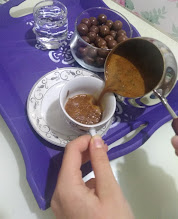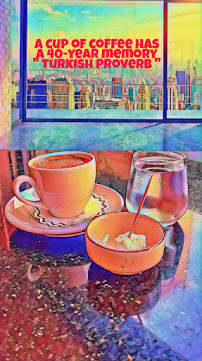Vesile Uslu/ Tes-iş Adapazarı Anatolian High School,Turkey
Prepared by Zeynep Ç,Sude Naz K,Sude Y,Emre Kenan U,Furkan Rıza P,Ali Ö.
Turkish coffee is one of the oldest methods of coffee preparation and brewing from the Ottoman Empire, which has an important place in Turkish culture. It has a unique identity and tradition with its unique taste, foam, smell, presentation style. It is the only type of coffee served with its grounds.
Turkish coffee is not only a beverage, but also a social work that brings together cultural gaps, social values and beliefs to socialize. The socialization role of Turkish coffee is based on the opening of the first coffeehouses in Istanbul, with their striking decorations. Coffeehouses in those times and still are places where people drink coffee, chat, share news, read books and socialize. Tradition itself is a symbol of hospitality, friendship, courtesy and fun. All of these are stated by the famous Turkish proverb "a cup of coffee has forty years' worth." This phrase shows how important coffee is in Turkish culture and how deeply it has penetrated Turkish culture.
In a short time, thanks to the merchants
and travelers who came to Istanbul and the Ottoman ambassadors, the taste and
fame of Turkish Coffee spread first to Europe and then to the whole world.In
2013, Turkish coffee culture and tradition took its place in UNESCO's
Intangible Cultural Heritage list.
The actual preparation of coffee requires many and very detailed steps and skills. First, freshly roasted quality coffee beans(optionally) are ground in a mortar or grinder until they become powder. Optionally, coffee, cold water and sugar are added to the pot. The coffee is placed on the stove and cooked so that foam is formed on the surface. Finally, it is served with a glass of water and Turkish delight. Achieving a good taste requires certain skills, such as the way the coffee is roasted and the degree of it. It is very important to roast all the coffee beans evenly and wait a while. As a means of entertainment, intelligible shapes inside the coffee cup are interpreted according to fortune telling 'rules'. It has been a traditional element of Religious Holidays and "Girl asking for marriage" ceremonies.
During the Ottoman period, when the guests came, the host immediately offered a coffee and put a glass of water next to it. If the guest drinks the water before the coffee, his stomach will come to hunger, the table will be set immediately, and this tradition continues today.

The sweetest member of Turkish cuisine, the best gift to give, the best companion with coffee, a nostalgia from childhood, a reason to love holidays; yes, you are right! We are talking about Turkish lokum. Here you are the facts you should know about lokum which dates back hundreds of years and is an important part of the Ottoman cuisine.
The
name Lokum is derived from the Arabic word "Rahat-ul hulküm". This
word means "relieves throat". Approximately 600 years since is
manufactured in Turkey and within our traditional desserts. Although it first
appeared in the 15th century, its entry into the Ottoman palaces took place in
the 17th century. The reason why it is a soft dessert is the wishes of the
sultans, especially Abdulhamit I. As a matter of fact, the soft delight
prepared by a dessert master named Muhittin Hacı Bekir upon the request of
Abdulhamit I, using refined sugar instead of molasses, became the first example
of Turkish delight today. The same dessert master introduced Turkish delight to
Europe in the 18th century.
Turkish delight
is an exquisite dessert known, recognized, and enjoyed in almost every country
in the world. It is even known as “Turkish Delight” in most countries of the
world (especially in North America). The Turkish delight is called
"Rahat" in Bosnia and Romania, "Delicia Turca" in Brazil,
and "Loukoumi" in Greece. The origin of the jelly, which is
frequently used in western cuisines, is based on Turkish delight. It is served
with Turkish coffee in almost all Balkan countries.
Lokum is made with citric acid, sugar, starch, food color and aroma. Sugar is boiled in water until it is fully dissolved. The citric acid and starch are left to dissolve in separate cups. Then citric acid and starch are mixed with sugar water. It is boiled for a while. The mixture is checked with a spoon whether it is in a sticky consistency, and it is kept in starchy cups for 20 hours. As a final step, it is shaped on rigid floor and packaged.


















No comments:
Post a Comment